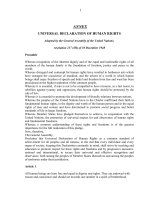part 4 estimation 1
Bạn đang xem bản rút gọn của tài liệu. Xem và tải ngay bản đầy đủ của tài liệu tại đây (788.59 KB, 29 trang )
Deterministic and Geostatistical
Estimation
Geostatistical Study Workflow
Traditional
Geostatistical
Weighted Linear Estimators
Kriging
Simple kriging
Kriging with External Drift
Cross Validation
Cokriging
Kriging Exercises
Steps in a Traditional Geological
Study
Establish stratigraphic framework
Establish facies, flow units and geologic prototype areas from logs and cores
Develop log database, develop statistical model for facies, flow units and
permeability from cored wells
Map facies, flow units and geologic areas across the field with log data
Note: traditional approach does not provide a measure of uncertainty in the spatial
distribution of facies flow units and associated φ - k in each geologic area
1
Steps in a Geostatistical Study
Establish stratigraphic framework
Establish facies, flow units and geologic prototype areas from logs and cores
Analyze the statistical φ - k relationship in core, log and seismic data to support
a facies / flow unit model in each geologic area
Perform a spatial continuity analysis of core/log and seismic data constrained by
stratigraphic framework
Estimate (map) facies, flow units or φ - k trends while honoring the stratigraphic
framework, the spatial continuity, and the spatial arrangement of core/log (hard)
or seismic
i i ((soft)
ft) data
d t
Simulate (model) facies, flow units or φ - k variability while honoring the
stratigraphic framework, the spatial continuity and the spatial arrangement of
core/log (hard) or seismic (soft) data
Goal of Estimation
We want our estimates to…
be unbiased (centered on the mean)
have minimum variation about the mean and
be based on a model
2
Estimation Methods
A wide variety of estimation methods have been designed for different types of
estimates:
Local or global estimates
Mean or full distribution of data values
Point or block values (require variograms)
Estimation Methods
All estimation methods involve a weighted linear estimation of sample data
values
n
Z * (u ) = ∑ λi Z (ui )
i =1
li - weights, Z(ui) known values at locations ui, Z*(u) estimate at location u
3
Weighted Linear Estimation
Example: Sand body with several wells with data (numbered) and a proposed
well location (?)
4
2
•3
1
?
Estimation Methods
There are many point estimation methods
Polynomial Regression (moving window average)
Triangulation
Inverse Distance Squared
Kriging
4
Estimation Methods
Moving Window Averages
Estimates are based on averages within a circle that moves with the point
being estimated
This method works best with dense data
Triangulation
Triangles are drawn to connect all of the points into a network
Contour locations are determined by
y linear interpolation
p
along
g the sides of
the triangles
uses nearest 3 data points
fast, simple
Estimation Methods
Inverse distance-squared
weighted average based on the distance (di) from the point where the
estimation is being made to the data value z(xi)
weights are commonly normalized
circular neighborhoods are commonly used to determine estimation data.
5
Estimation Methods
Kriging
a minimum variance estimator based on a knowledge of variograms
an unbiased estimate that accounts for the data
provides for data declustering
Weighted Linear Estimation
What factors should we consider in assigning the weights?
Closeness to the location
Redundancy between the data values
4
Preferential direction of continuity
Variability
1.5
50
1
6
40
2
3
?
6
Assigning Weights
Polygon-type estimates
Inverse distance estimates
Local sample mean estimates
Local sample median estimates
Use variogram => kriging
Polygon-type estimates
Weight = 1, Within a Polygon
7
Weighted Linear Estimators
Assign all of the weight to the nearest data (polygonal-type estimate)
Assign the weights inversely proportional to the distance from the location being
1
estimated ((inverse distance schemes)
)w
λi =
∑
c + di
1
n
i =1
c + d iw
where di is the distance between data i and the location being
estimated, c is a small constant, and ω is a power (usually between 1 to 3).
Shortcomings of Estimation
Methods
Weights are based on arbitrary schemes (no model)
Estimates are biased towards clustered values (except for kriging)
No measure of the accuracy of the estimates (except for kriging)
Estimated field of values is much smoother than the underlying random field
which was sampled (true for all estimation methods)
8
Variograms
Modeling Spatial Correlation
Data points further away from a point to be kriged are less correlated than those
closer
7000 to the point
Variogram Model
7100
3km
2km
Point to
be Kriged
1km
V
a
r
i
a
n
c
e
1
7400
2
3
4km
Kriging Example using Well Data
Well Data
Variogram
Model
Kriging
Kriged Map
9
Properties of Kriging
Kriging provides the Best Linear Unbiased Estimate (BLUE)
Kriging is an exact interpolator (kriged estimates match data value at data
locations)
Kriging system depends only on the covariance's and data configuration, not the
data values
By accounting for configuration, Kriging declusters the data
The kriging error is uncorrelated with the kriged distribution (important for
conditional simulation)
Problems in application of kriging to reservoir modeling
Underrepresents the variability
Deterministic and cannot be used for estimation of uncertainty
The fields generated tend to be Gaussian
Kriging
Kriging is a procedure for constructing a minimum error variance linear estimate at
a location where the true value is unknown
The main controls on the kriging weights are:
closeness of the data to the location being estimated
redundancy between the data
the variogram
Simple Kriging (SK) does not constrain the weights and works with the residual from
the mean
Ordinary Kriging (OK) constrains the sum of the weights to be 1.0, therefore, the
mean does
d
nott need
d tto be
b kknown
Two implicit assumptions are stationarity (work around with different types of
kriging) and ergodicity (more slippery)
Kriging is not used directly for mapping the spatial distribution of an attribute.
10
Types of Kriging
n
Simple m
Kriging
(SK):
*
= λ ⋅ z ( u ) + ⎡1 −
SK
∑
i =1
i
i
⎢⎣
∑ λ ⎤⎥⎦ ⋅ m
n
i =1
i
global
n
Ordinary *Kriging
(OK)
mOK = ∑ λi ⋅ z ( ui )
i =1
Other Types:
Universal Kriging (UK)
accounts for simple trends
External Drift
accounts for more complex trends
Locally Varying Mean
accounts for secondary information
Some Definitions
Consider the residual data values:
Y ⎛⎜⎜⎝ui ⎞⎟⎟⎠ = Z ⎛⎜⎜u ⎞⎟⎟ − m⎛⎜⎜u ⎞⎟⎟, i =1,...,n
⎝ i⎠
⎝ i⎠
where m(u) could be constant, locally varying, or considered constant but
unknown.
11
Some Definitions
{
Variogram is defined as:
2γ (h ) = E [Y (u ) − Y (u + h )]
2
}
C (h ) = {Y (u )⋅Y (u + h )}
Covariance is defined as:
Some Definitions
Link between the Variogram and Covariance:
2γ (h ) = [E{Y 2 (u )}]+ [E{Y 2 (u + h )}]
− 2 ⋅ [E{Y (u )⋅Y (u + h )}]
=Var{Y (u )}+ Var{Y (u + h )}− 2 ⋅ C (h )
= 2[C (0 ) − C (h )]
So, C(h) = C(0) - γ(h)
12
Simple Kriging
Consider a linear estimator:
Y (u ) = i∑=1 λi ⋅Y (ui )
n
*
where Y(ui) are the residual data (data values minus the mean) and Y*(u) is the
estimate
Simple Kriging
{[
] }=
= E {[Y (u )] }− 2 ⋅ E {Y (u ) ⋅ Y (u )}+ E {[Y (u )] }
The error variance is defined as
2
*
E Y (u ) − Y (u )
*
2
2
*
= i∑=1 j∑=1λiλjE{Y (ui ) ⋅ Y (uj )}− 2 ⋅ i∑=1λiE{Y (u ) ⋅ Y (ui )}+ C (0 )
n
n
n
= i∑=1 j∑=1λiλjC (ui , uj ) − 2 ⋅ i∑=1λiC (ui , uj ) + C (0 )
n
n
n
13
Simple Kriging System
Optimal weights λi, i = 1,…,n may be determined by setting partial derivatives of
the error variance w.r.t. the weights to zero
n
∂[ ]
= 2 ⋅ j∑=1λjC (ui, uj ) − 2 ⋅ C (u , ui ), i = 1,..., n
∂λi
n
∑ λ C (u u ) = C (u u ), i = 1,..., n
j
i,
j
,
i
j =1
Simple Kriging: Some Details
2
γ1,2
γ2,3
γ1,3
1
3
γ0,2
γ0,1
γ0,3
?
0
1
2
3
4
5
14
Simple Kriging: Some Details
•
There are three equations to determine the three weights:
λ 1 ⋅ C (1,1) + λ 2 ⋅ C (1,2) + λ 3 ⋅ C (1,3) = C (0,1)
λ 1 ⋅ C (2,1) + λ 2 ⋅ C (2,2) + λ 3 ⋅ C (2,3) = C (0,2 )
λ 1 ⋅ C (3,1) + λ 2 ⋅ C (3,2) + λ 3 ⋅ C (3,3) = C (0,3)
Simple Kriging: Some Details
In matrix notation:
(Recall that C(h) = C(0) - γ(h))
⎡C (1,1) C (1,2 ) C (1,3) ⎤ ⎡λ 1 ⎤ ⎡C (0,1) ⎤
⎢C (2,1) C (2,2 ) C (2,3)⎥ ⎢λ 2 ⎥ = ⎢C (0,2 )⎥
⎢
⎥⎢ ⎥ ⎢
⎥
⎣⎢C (3,1) C (3,2 ) C (3,3) ⎦⎥ ⎢⎣λ 3 ⎦⎥ ⎣⎢C (0,3) ⎦⎥
15
Simple Kriging
Changing the Range
Simple kriging with a zero nugget effect and an isotropic spherical variogram
with three different ranges:
g
λ1
range = 10
5
1
λ
0.781
0.648
0.000
λ
2
0.012
-0.027
0.000
3
0.065
0.001
0.000
Simple Kriging
Changing the Nugget Effect
Simple kriging with an isotropic spherical variogram with a range of 10 distance
units and three different nugget
gg effects:
λ
nugget = 0%
25%
75%
100%
1
0.781
0.468
0.172
0.000
λ
2
0.012
0.203
0.130
0.000
λ
3
0.065
0.064
0.053
0.000
16
Simple Kriging
Changing the Anisotropy
Simple kriging with a spherical variogram with a nugget of 25%, a principal
range of 10 distance units and different “minor” ranges:
λ
anisotropy 1:1
2:1
5:1
20:1
1
0.468
0.395
0.152
0.000
λ
2
0.203
0.087
-0.055
0.000
λ
3
0.064
0.141
0.232
0.239
Kriging Example
W1
120
P
?
Distance between Wells
Well 1
Well 2
Well 1
0
3.35
Well 2
3.35
0
Well 3
2.88
1.3
P
1
3.32
W2
103
W3
142
X/Y Position of Wells
X
Y
Well 1
3.0
4.0
Well 2
6.3
3.4
Well 3
2.0
1.3
P
3.0
3.0
Value
120
103
142
Well 3
2.88
4.79
0
1.97
P
1.00
3.32
1.97
0
SemiVariance for Wells and Location P
Well 1
Well 2
Well 3
P
Well 1
0
13.42
11.52
4.00
Well 2
13.42
0
19.14
13.30
Well 3
11.52
19.14
0
7.89
17
Kriging Example
[
-0.0680
0.0680
0.0326
0.0354
0.1932
0.0326
-0.0433
0.0106
0.4072
0.0354
0.0106
-0.0461
0.3995
0.1932
0.4072
0.3995
-9.5851
]
[ ][ ]
W1
W2
W3
λ
=
0.5954
0
5954
0.0975
0.3071
-0.7298
Yp = 0.5954(120) + 0.0975(103) + 0.3071(142)
= 125.1
Error Variance = 0.5954(4)
( ) + 0.0975(12.1)
(
) + 0.3071(7.9)
( ) - 0.7298(1)
( )
= Sqrt(5.25) = 2.3
Yp = 125.1 +/- 4.6 with 95% Probability
Kriging with External Drift
Implicit correlation between primary and secondary (external variable)
Requirements
external variable needs to vary smoothly in space (kriging system may
otherwise by unstable
external variable must be known at all locations of the primary data and at
the estimation locations
need to calculate and model the variogram of residuals for the primary
variable
Kriging with an external drift yields a map which reflects the spatial trend of the
secondary variable
18
Kriging with External Drift Example
using Well and Seismic Data
Well Data
Variogram
Model
Kriging with
External Drift
Kriging
K
i i with
ith
External Drift Map
Seismic Data
Cross-Validation
Cross-validation is an attempt to check how well the estimation procedure can
be expected to perform
this is accomplished by comparing estimates with true values in production
areas
the way around this is to re-estimate each known sample value at the time for
surrounding information
cross-validation may provide the following
warnings, invalidation
reveall weaknesses,
k
shortcomings
h t
i
suggest improvements
it will never provide any guarantee
19
Cross-validation
Analyze the error distribution
error = estimated - actual
The items to look for are
averaged error (global bias)
spread (standard deviation)
maximum, minimum error
shape of distribution
Plot the residual on maps
any persistent
i t t overestimation
ti ti
any persistent underestimation's
Which criterion is relevant to the study?
misclassification
minimizing underestimation
minimizing overestimation
Cross Validation
100
K Estimated
10
1
0.1
0.01
0.01
0.1
1
10
100
K True
20
Cross Validation
120
100.00%
90.00%
100
80.00%
Frequency
80
Freq.. Estimated
70.00%
Frequency True
60.00%
Cum. % True
60
50.00%
Cum. % Estim.
40
40.00%
30.00%
20.00%
20
10.00%
0
.00%
0
4
8
12
16
20
24
28
32
36
k Range
Cross Validation
Mean
Standard Error
Median
Mode
Standard Deviation
Sample Varianc e
Kurtosis
Skewness
Range
Minimum
Maximum
Sum
Count
Q3 - Largest ( 35 )
Q1 - Smallest ( 35 )
Confidenc e Level ( 95.0% )
K True
K Estimated
4.350
0.569
2.195
0.190
6.727
45.247
29.837
4.450
58.260
0.060
58.320
609.060
140
5.380
0.670
1.124
4.608
0.400
3.215
1.837
4.732
22.395
7.203
2.290
26.958
-0.193
26.765
645.144
140
6.183
1.092
0.791
21
Kriging - Effective Porosity
Egyptian Example
Two porosity models:
High Resolution Model (geocellular model
resolution)
200 vertical layers
320,000 Model cells
Low Resolution model
30 vertical layers
48,000
48 000 M
Model
d l cells
ll
High Resolution Model
200 vertical layers
320,000 model cells
22
Intermediate
32 vertical layers
48,000 Model cells
Cokriging
Problem
Petrophysical data (e.g. porosity,permeability) is sampled sparsely (i.e. at
wells)
Seismic data (amplitude) is sampled densely but does not directly measure
desired property (e.g. porosity or permeability)
A solution
Cokriging correlates desired undersampled reservoir property to widely
sampled parameter
23
Cokriging Example
Using Well and Seismic Data
Well Data
Variogram
g
Model
CrossVariogram
Model
Cokriging
Cokriged Map
Variogram
Model
Seismic Data
Cokriging
The system of equations is the same as for simple kriging with one spatial variable
The cokriging system requires more inference of the correlation's between the different
variables and their spatial correlation's
The cokriging system requires measurement and modeling of the covariance's of each of
the data types and the cross-covariance's of each data type with the others
Cokriging is the most labor intensive option since it requires variograms of the secondary
variable as well as a cross covariance.
It is the slowest algorithm to run because the matrix is far more complicated since it must
handle the additional covariance values from the primary and secondary variables as well
as the cross covariance.
Cokriging is best used when the primary variable is significantly undersampled while the
secondary variable is well sampled. It is also recommended when the secondary variable
is quite heterogeneous.
Cokriging does not require, like KT or KED, that the secondary sample be smoothly
varying. Neither is it required that the secondary variable exist at the primary data
locations and the locations to be estimated like KED.
The same variogram model type must be used for primary, secondary and cross
variograms.
24
Cokriging Example
Kriged Sand Isopach Map
Using Well Data Only
Sand thicknesses posted adjacent to wells.
Note smoothing of data in contour map.
Proposed
Well
(modified from Wolf and others, 1994)
Cokriging Example
Kriged Peak Amplitude Map
Note that high amplitudes generally correspond to thick sands
25








